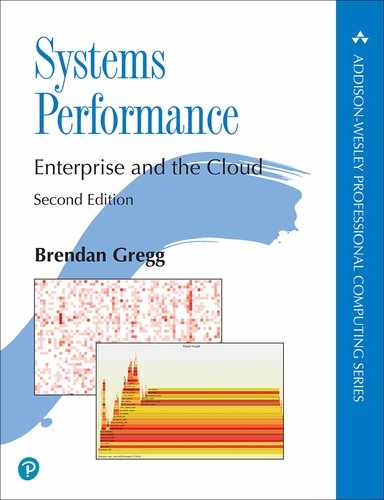Acknowledgments
Thanks to all those who bought the first edition, especially those who made it recommended or required reading at their companies. Your support for the first edition has led to the creation of this second edition. Thank you.
This is the latest book on systems performance, but not the first. I’d like to thank prior authors for their work, work that I have built upon and referenced in this text. In particular I’d like to thank Adrian Cockcroft, Jim Mauro, Richard McDougall, Mike Loukides, and Raj Jain. As they have helped me, I hope to help you.
I’m grateful for everyone who provided feedback on this edition:
Deirdré Straughan has again supported me in various ways throughout this book, including using her years of experience in technical copy editing to improve every page. The words you read are from both of us. We enjoy not just spending time together (we are married now), but also working together. Thank you.
Philipp Marek is an IT forensics specialist, IT architect, and performance engineer at the Austrian Federal Computing Center. He provided early technical feedback on every topic in this book (an amazing feat) and even spotted problems in the first edition text. Philipp started programming in 1983 on a 6502, and has been looking for additional CPU cycles ever since. Thanks, Philipp, for your expertise and relentless work.
Dale Hamel (Shopify) also reviewed every chapter, providing important insights for various cloud technologies, and another consistent point of view across the entire book. Thanks for taking this on, Dale—right after helping with the BPF book!
Daniel Borkmann (Isovalent) provided deep technical feedback for a number of chapters, especially the networking chapter, helping me to better understand the complexities and technologies involved. Daniel is a Linux kernel maintainer with years of experience working on the kernel network stack and extended BPF. Thank you, Daniel, for the expertise and rigor.
I’m especially thankful that perf maintainer Arnaldo Carvalho de Melo (Red Hat) helped with Chapter 13, perf; and Ftrace creator Steven Rostedt (VMware) helped with Chapter 14, Ftrace, two topics that I had not covered well enough in the first edition. Apart from their help with this book, I also appreciate their excellent work on these advanced performance tools, tools that I’ve used to solve countless production issues at Netflix.
It has been a pleasure to have Dominic Kay pick through several chapters and find even more ways to improve their readability and technical accuracy. Dominic also helped with the first edition (and before that, was my colleague at Sun Microsystems working on performance). Thank you, Dominic.
My current performance colleague at Netflix, Amer Ather, provided excellent feedback on several chapters. Amer is a go-to engineer for understanding complex technologies. Zachary Jones (Verizon) also provided feedback for complex topics, and shared his performance expertise to improve the book. Thank you, Amer and Zachary.
A number of reviewers took on multiple chapters and engaged in discussion on specific topics: Alejandro Proaño (Amazon), Bikash Sharma (Facebook), Cory Lueninghoener (Los Alamos National Laboratory), Greg Dunn (Amazon), John Arrasjid (Ottometric), Justin Garrison (Amazon), Michael Hausenblas (Amazon), and Patrick Cable (Threat Stack). Thanks, all, for your technical help and enthusiasm for the book.
Also thanks to Aditya Sarwade (Facebook), Andrew Gallatin (Netflix), Bas Smit, George Neville-Neil (JUUL Labs), Jens Axboe (Facebook), Joel Fernandes (Google), Randall Stewart (Netflix), Stephane Eranian (Google), and Toke Høiland-Jørgensen (Red Hat), for answering questions and timely technical feedback.
The contributors to my earlier book, BPF Performance Tools, have indirectly helped, as some material in this edition is based on that earlier book. That material was improved thanks to Alastair Robertson (Yellowbrick Data), Alexei Starovoitov (Facebook), Daniel Borkmann, Jason Koch (Netflix), Mary Marchini (Netflix), Masami Hiramatsu (Linaro), Mathieu Desnoyers (EfficiOS), Yonghong Song (Facebook), and more. See that book for the full acknowledgments.
This second edition builds upon the work in the first edition. The acknowledgments from the first edition thanked the many people who supported and contributed to that work; in summary, across multiple chapters I had technical feedback from Adam Leventhal, Carlos Cardenas, Darryl Gove, Dominic Kay, Jerry Jelinek, Jim Mauro, Max Bruning, Richard Lowe, and Robert Mustacchi. I also had feedback and support from Adrian Cockcroft, Bryan Cantrill, Dan McDonald, David Pacheco, Keith Wesolowski, Marsell Kukuljevic-Pearce, and Paul Eggleton. Roch Bourbonnais and Richard McDougall helped indirectly as I learned so much from their prior performance engineering work, and Jason Hoffman helped behind the scenes to make the first edition possible.
The Linux kernel is complicated and ever-changing, and I appreciate the stellar work by Jonathan Corbet and Jake Edge of lwn.net for summarizing so many deep topics. Many of their articles are referenced in this book.
A special thanks to Greg Doench, executive editor at Pearson, for his help, encouragement, and flexibility in making this process more efficient than ever. Thanks to content producer Julie Nahil (Pearson) and project manager Rachel Paul, for their attention to detail and help in delivering a quality book. Thanks to copy editor Kim Wimpsett for the working through another one of my lengthy and deeply technical books, finding many ways to improve the text.
And thanks, Mitchell, for your patience and understanding.
Since the first edition, I’ve continued to work as a performance engineer, debugging issues everywhere in the stack, from applications to metal. I now have many new experiences with performance tuning hypervisors, analyzing runtimes including the JVM, using tracers including Ftrace and BPF in production, and coping with the fast pace of changes in the Netflix microservices environment and the Linux kernel. So much of this is not well documented, and it had been daunting to consider what I needed to do for this edition. But I like a challenge.
